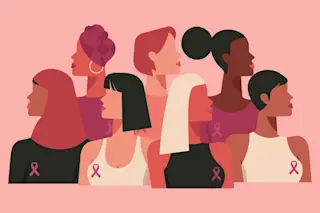Breast cancer is one of the world’s most prevalent types of cancer worldwide. It is a tumor that starts in the milk ducts of the breast and then spreads into the surrounding breast tissue and, sometimes, other parts of the body.
About 98 percent of women who are diagnosed with breast cancer at stage 1 will live another five years and more, according to the Centers for Disease Control and Prevention. But just an estimated 25 percent of women survive if their cancer is diagnosed when it’s already spread to other organs.
The number of people being diagnosed with breast cancer has been skyrocketing in the past years, with younger women being increasingly affected, so much so that, in the U.S., breast cancer has been branded as an “epidemic.”
What this means, why this is happening, and what should be done about it is something thousands of experts in the field of cancer research are working hard to discover.
Breast Cancer Statistics
In 2020, across the globe, 2.3 million women were diagnosed with breast cancer and 685,000 of them died because of it, according to the World Health Organization. By the end of that year, breast cancer accounted for nearly 12 percent of all new cancer cases diagnosed, and there were 7.8 million women alive who had been diagnosed with breast cancer since 2015. In the U.S., breast cancer is expected to increase by 25 percent by the year 2040.
“Breast cancer is the most diagnosed cancer globally except for skin cancers,” says Olga Golubnitschaja, the head of the Predictive, Preventive Personalized Medicine oncology unit at the University Hospital Bonn, in Germany.
“The incidence of breast cancer has doubled in the last few decades in 60 out of 102 countries worldwide. This is absolutely [an epidemic] now,” says Golubnitschaja.
The victims of breast tumors are largely females, but about 0.5 to 1 percent of breast cancers affect men, for whom breast cancer is a little different. Golubnitschaja also suspects that the more unexpected breast cancer is in a patient — for instance, if the patient is a younger woman or a man — there is a higher mortality rate.
Out of the 290,000 new female and 2,700 new male invasive breast cancers that were diagnosed in 2022, according to the American Cancer Society, 15 percent of females died, while 20 percent of males died.
Read More: How Viruses Could Cure Cancer and Save Lives
Has the Diagnosis of Breast Cancer Improved?
There isn’t always a clear-cut consensus on the statistics behind growing numbers of breast cancer because skeptics argue that experts have just gotten better at diagnosing it. The more you look for it, the more you find it: that’s why numbers have been going up.
“But only a minor part of the increased breast cancer cohort may be attributed to improved detection,” Golubnitschaja says.
Statistics from the period of time between 1950 and 1975 in the U.S., when there still was no new fancy detection technology, the incidence of breast cancer cases per every 100,000 people increased from 66.6 to 119.2 cases, according to a 2003 study in the Journal of the National Cancer Institute.
Similarly, research from the Japanese Breast Cancer Society suggests that only 20 percent of breast cancer cases being detected by screening are asymptomatic and would have gone unnoticed otherwise.
Read More: A Blood Test That Screens For Multiple Cancers At Once Promises To Boost Early Detection
What Causes Breast Cancer?
Breast cancer is a complex disease with many contributing factors. For diseases as complicated as cancer, there are what experts call modifiable and nonmodifiable risk factors — things that are intrinsic to your biology, and things that you have chosen as your lifestyle.
“To be honest, I have not seen any breast cancer patients who had only breast cancer. There are many many, many other things that accumulate and certainly synergistically work together,” says Golubnitschaja.
Genetics
Certain inherited gene mutations can increase breast cancer risk, mainly a mutation in the genes called BRCA1, BRCA2, and PALB-2. But genetics only plays a role in about 5 percent to 10 percent of the population affected by breast cancer,and even when the mutated genes are there, it’s not 100 percent certain the patient will get cancer.
Hormones
Hormonal factors, such as exposure to estrogen, can influence your risk, too. This includes early menstruation, late menopause, and certain hormone replacement therapies. Estrogen receptor positive breast cancers are a type of breast cancer that reacts to estrogen. The cancer cells have receptors that, when activated by estrogen, make the cancer grow.
Family History
Having a close relative (e.g., mother, sister) with breast cancer can increase your risk. The Centers for Disease Control and Prevention recommends letting your doctor know if you have a relative who was diagnosed with breast cancer before the age of 50.
Age
The risk of breast cancer increases with age, and it typically affects middle-aged and older women. The average age for breast cancer diagnosis is around 62.
Environmental Factors
While the link is not fully understood, certain environmental factors and pollutants have been studied for potential associations with breast cancer. Specifically, chemicals in the environment that act like estrogen are a concern. These substances may be found in plastics, cosmetics, personal care items, and pesticides.
Reproductive and Menstrual History
Delayed childbearing or never having children may increase the risk for breast cancer, also women who had their first period at an early age or experienced a late menopause may have a slightly higher risk.
Breast Density
High breast density on mammograms can be associated with an increased risk. Women with high breast density have a 4-6 times greater chance of developing breast cancer.
Lifestyle
Lifestyle is massively to blame. “The role of women is very much shifted in our society,” says Golubnitschaja. “More career women, less breastfeeding.” There has been an increase in the stress women experience, a big sleep deficit, as well as more sedentary lifestyles, including more alcohol and smoking, environmental pollution, and exposure to toxic chemicals. There’s also a shift to Western diets that replete with processed foods, red meat, added sugars — and other factors scientists are yet to discover.
Read More: Cancer Cells Most Active During Sleep, Study Finds
Examples of Lifestyle Choices and Cancer
An extreme example of how lifestyle affects breast cancer incidence, according to Golubnitschaja, can be found when comparing the statistics for Japan compared to the U.S. Japan is one of the developed countries with the lowest incidence of breast cancer worldwide, and the U.S., is one of the developed countries with the highest incidence.
“Japanese women, moving from Japan to the U.S., reach the same incidence within the same generation,” says Golubnitschaja.
It’s lifestyle factors like these that might be causing a spike in the number of younger women, who hadn’t historically been a target of breast cancer, that are now being diagnosed with the condition. This has caused a big gap in the therapeutic market, as it’s caught medical doctors by surprise.
“This is the big tragedy in our society. We are not skilled for this population,” says Golubnitschaja. “With postmenopausal women, aged 60-plus, the system works very well,” and the disease gets less dangerous because their metabolic systems are slowing down, so the cancer takes longer to spread.
Read More: Why Is It So Hard to Find a Cure for Cancer?
What Is a Mammogram?
The mammogram involves using low-dose X-rays to create detailed images of the breast, and is one of the main tools used for diagnosing breast cancer. It is helpful for women in their 50s, but rather counterproductive for young females, according to Golubnitschaja.
Diagnosing Breast Cancer
One of the reasons the medical system has been failing younger women in diagnosing breast cancer quickly is the reliability of breast cancer screening with a mammogram. Younger women have much denser breast tissues than older ones, so many small tumors still remain undetected.
False-negative Breast Cancer Diagnosis
For these younger women, it’s easy to get a false-negative diagnosis. This also comes with a whole swath of negative mental health side effects. Mammograms have a limit to what they can detect, and they get bad when it comes to spotting tumors under 1 centimeter in size: But if the tumor has gotten to that size, it’s already too late for the type of aggressive metastatic syndrome that’s been affecting younger generations of women.
Of course, other experts argue that being extra sure is better than not checking, so the benefits outweigh the harm, and this is the core of early detection and prevention.
Read More: Developing A Drug To Identify And Target Tricky Cancer Cells
Improving the Diagnosis of Breast Cancer
Since mammograms haven’t been proving all that effective with younger populations, the prevention system for breast cancer needs to be much more holistic. “It makes no sense to do prevention for everybody the same,” says Golubnitschaja.
Personalized Breast Cancer Risk Assessments
This means doing a health-risk assessment adapted from person to person. One thing her team proposes is an approach based on patterns, in the groups of people who are affected, to describe a phenotype of a cancer-at-risk person.
One of these groups is obese women with a family predisposition to breast and prostate cancer. Another category is women affected by what experts call Flammer syndrome — young women, with low body mass indexes, who are perfectionists with meticulous personalities and dedicated to their careers. These women tend to suffer from disturbed microcirculation, shifted sleep patterns, and are easily dehydrated, and have suboptimal health at a cellular level.
“There is a direct link between physiology and the ‘breast cancer picture,’” says Golubnitschaja.
Improved Breast Cancer Screenings
Giving more power to primary care physicians could be a first step in seeking these patterns, as could new technologies that are emerging to allow for breast cancer screening that is accurate and personalized.
“Definitely as soon as possible, we need to shift the paradigm from reactive medicine to predictive, preventive, and personalized medicine,” says Golubnitschaja. “We need to change the strategy.”
Countries that are successfully reducing their breast cancer mortality rates are decreasing mortality by 2 to 4 percent each year, according to the WHO. In fact, the WHO’s Global Breast Cancer Initiative plans to reduce global breast cancer mortality by 2.5 percent every year, which would already be enough to avoid 2.5 million breast cancer deaths from now until 2040.
Read More: Taking A Closer Look at AI and Disease Diagnostics















